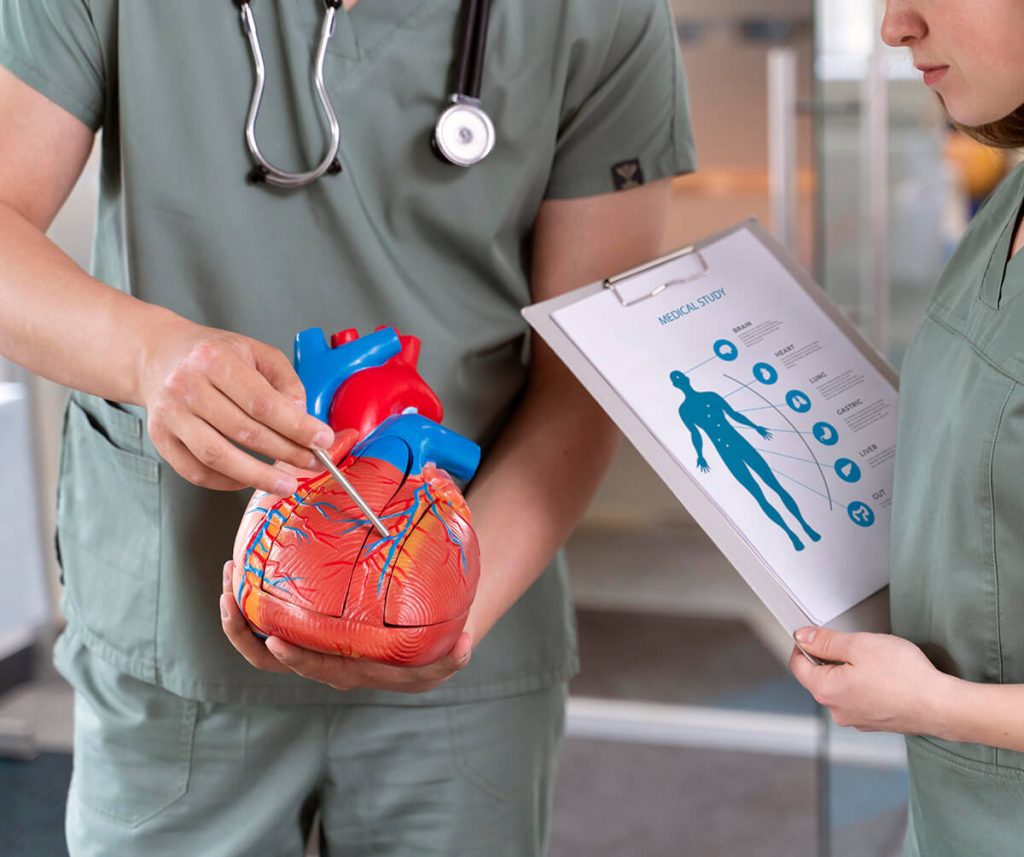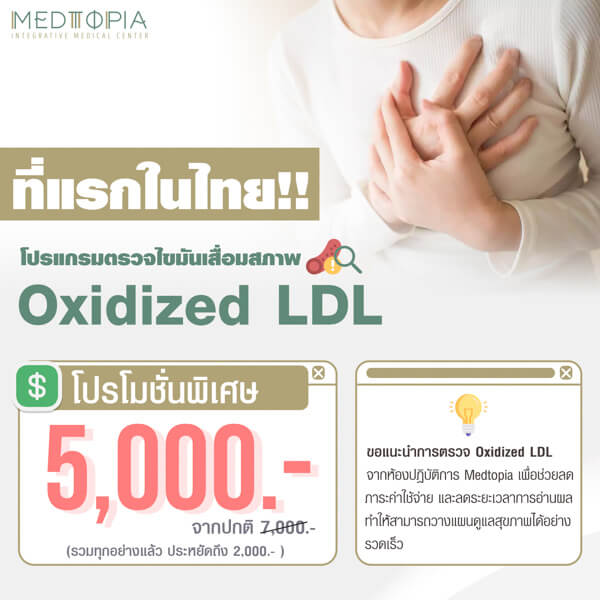LDL Cholesterol
The heart and brain are vital organs that require a constant supply of oxygen. Just a few minutes without adequate blood flow can be life-threatening. However, for blood vessels to become so narrowed or blocked that blood cannot flow through, it often takes decades of progressive fat buildup along the artery walls. If we can detect early signs of fat accumulation or arterial stiffness, we can plan timely treatments and take preventive measures before it’s too late.
When discussing health screenings related to heart and vascular disease risk, cholesterol levels often come to mind first—especially LDL cholesterol, which has long been considered a key marker. LDL has gained a notorious reputation, commonly referred to as “bad cholesterol.” But in reality, LDL is not inherently bad—it is, in fact, an essential fat.
Approximately 75–80% of the LDL found in our bloodstream is produced by our own body, with only 15–20% coming from food. The reason our body generates LDL in such quantities is because it needs it. LDL plays critical roles in building cell membranes, producing vitamin D, synthesizing hormones, forming bile acids, supporting the nervous system, and performing many other essential biological functions.

Rethinking LDL: The Misunderstood Cholesterol
LDL cholesterol has long been accused of being the “villain” in cardiovascular disease, widely misunderstood as the fat that clogs arteries. In truth, however, normal LDL is an essential fat that functions as a delivery vehicle—transporting lipids through the bloodstream to target cells, much like a parcel being sent to a recipient. It doesn’t normally accumulate in blood vessels along the way.
The real problem begins when LDL becomes damaged or degraded and is no longer usable by the body. At this stage, it gets discarded and left behind in the arterial walls. This degraded form is called Oxidized LDL (OxLDL).
Medical statistics reveal a surprising fact: over half of the individuals who suffer from arterial blockages or heart attacks have normal or even low levels of LDL in their blood. Furthermore, in patients with high cholesterol, treating 10 individuals with cholesterol-lowering drugs to reduce LDL levels only prevents arterial disease in 1 of them.
This suggests that, instead of focusing solely on general LDL levels—which the body actually needs—we should pay more attention to Oxidized LDL (OxLDL), the harmful byproduct that directly contributes to plaque buildup in arteries. In the past, OxLDL testing was expensive (often costing tens of thousands of baht) and time-consuming, as samples had to be sent abroad. Today, however, OxLDL can be tested locally in Thailand, reducing the cost to just a few thousand baht and delivering results within 7 days—making the test both more accessible and practical.
It’s important to note that the presence of OxLDL in the arterial wall marks just the beginning of arterial disease. At first, these fat deposits are soft, allowing the arteries to retain some flexibility and still permit blood flow. But over time, calcium builds up around these deposits, hardening them into plaque and leading to arterial calcification. This loss of elasticity prevents the artery from expanding properly during heartbeats, resulting in the serious and irreversible condition of true arterial blockage.

Coronary Arteries
We can assess the extent of calcium buildup in the coronary arteries through a test called the CT Calcium Score (also known as the Coronary Artery Calcium Score or CAC). If the calcium score is over 100, it indicates a moderate risk of arterial narrowing. A score above 400 indicates a high risk of developing significant coronary artery disease.
In addition to Oxidized LDL (OxLDL) and the CT Calcium Score, there are several blood tests that can help evaluate the health and strength of your blood vessels, such as:
-
Homocysteine: Indicates inflammation within the blood vessels.
-
hs-CRP (high-sensitivity C-reactive protein): Reflects inflammation or tissue damage within the body.
-
Ferritin: Assesses platelet function and can help predict platelet aggregation and the formation of blood clots.
These markers together provide a comprehensive view of cardiovascular risk and can support early prevention strategies.
However, detecting a risk of arterial blockage does not definitively mean that an artery will become completely blocked, or that a heart attack or stroke is inevitable. With advanced cardiovascular health screenings, it is possible to identify the underlying causes of vascular problems and take timely preventive measures. These may include using concentrated nutrients to stimulate vascular repair, selecting specific vitamins that help dissolve calcium from arterial walls, administering intravenous nutrients to increase antioxidant levels and reduce the risk of LDL oxidation, taking medications that stimulate stem cell activity to help cleanse the blood vessels, using nutrients that reduce vascular inflammation and promote arterial cleansing, or undergoing chelation therapy to lower calcium buildup within blood vessel walls.
Additionally, in individuals who already have narrowed arteries, it is possible to assess their risk of recurrence. If a high likelihood of future arterial blockage is found, treatment with medically derived stem cells may be considered to enhance vascular and heart tissue repair. According to medical data and research, the use of at least 100 million mesenchymal stem cells (MSCs) in patients with ischemic heart disease has been shown to significantly support the repair of blood vessels and heart cells. This therapy also improves tissue survival, helps maintain the heart’s pumping function, promotes new blood vessel formation, reduces inflammation in blood vessels and cardiac tissue, stimulates the generation of new heart cells, and decreases the risk of scar tissue formation caused by oxygen deprivation in the heart.
|
Recommended Deep Heart Screening Program |
|
|---|---|
| Test | Price (THB) |
| Oxidized LDL (Degraded LDL) | 5,000 |
Lipoprotein(a) (Sticky Cholesterol) |
750 |
Apolipoprotein A1 (Cholesterol Accumulation in Tissue) |
750 |
Apolipoprotein B (Excess Cholesterol Recycling) |
750 |
Fibrinogen Level (Blood Clot Formation) |
1,000 |
D-Dimer (Blood Clot Quantity) |
1,000 |
Serum Ferritin (Stored Iron Level) |
800 |
Electrocardiogram (EKG) |
600 |
| Total Price | 10,650 |
| Special Package Price | 7,990 (25% off) |
You can also add these additional tests at special discounted prices:
- Coenzyme Q10 (Blood Level) — Regular Price: 5,000 THB → Special Price 3,750 THB
- CT Calcium Score (Coronary Artery Calcium) — Regular Price: 5,320 THB → Special Price 2,500 THB
| Recommended Program: Heart and Vascular Disease Prevention | |
|---|---|
| Service | Price (THB) |
| IV Nutrient Therapy (10 sessions) | 60,000 |
| IV Chelation Therapy (10 sessions) | 60,000 |
| Personalized Precision Supplements | 20,000 |
| Cardio Medicine Budget | 15,000 |
| Total Value | 155,000 |
| Special Package Price | 124,000 (ลด 20% off) |
Bonus: Free Oxidized LDL (OxLDL) test – 2 sessions (Value: 10,000 THB)
| Recommended Program: Cellular-Level Heart Regeneration | |
|---|---|
| Service |
Price (THB)
|
| IV Nutrient Therapy (10 sessions) | 60,000 |
| IV Chelation Therapy (10 sessions) | 60,000 |
| Personalized Precision Supplements | 20,000 |
| Cardio Medicine Budget | 15,000 |
| Cultured Stem Cells – U-MSCs (100 million cells) | 2,000,000 |
| Total Value | 2,155,000 |
| Special Package Price | 1,500,000 (30+% Discount) |
Bonuses Included:
-
Free NAD+ Therapy – 15 vials (Value: 150,000 THB)
-
Free Advanced Health Check-up (Value: 109,330 THB)
-
Free Blood Detox Therapy – 1 session (Value: 120,000 THB)
-
Free PRP Ready – 6 sessions (Value: 30,000 THB)
-
Free Placenta Extract – 6 sessions (Value: 30,000 THB)

 ไทย
ไทย
















